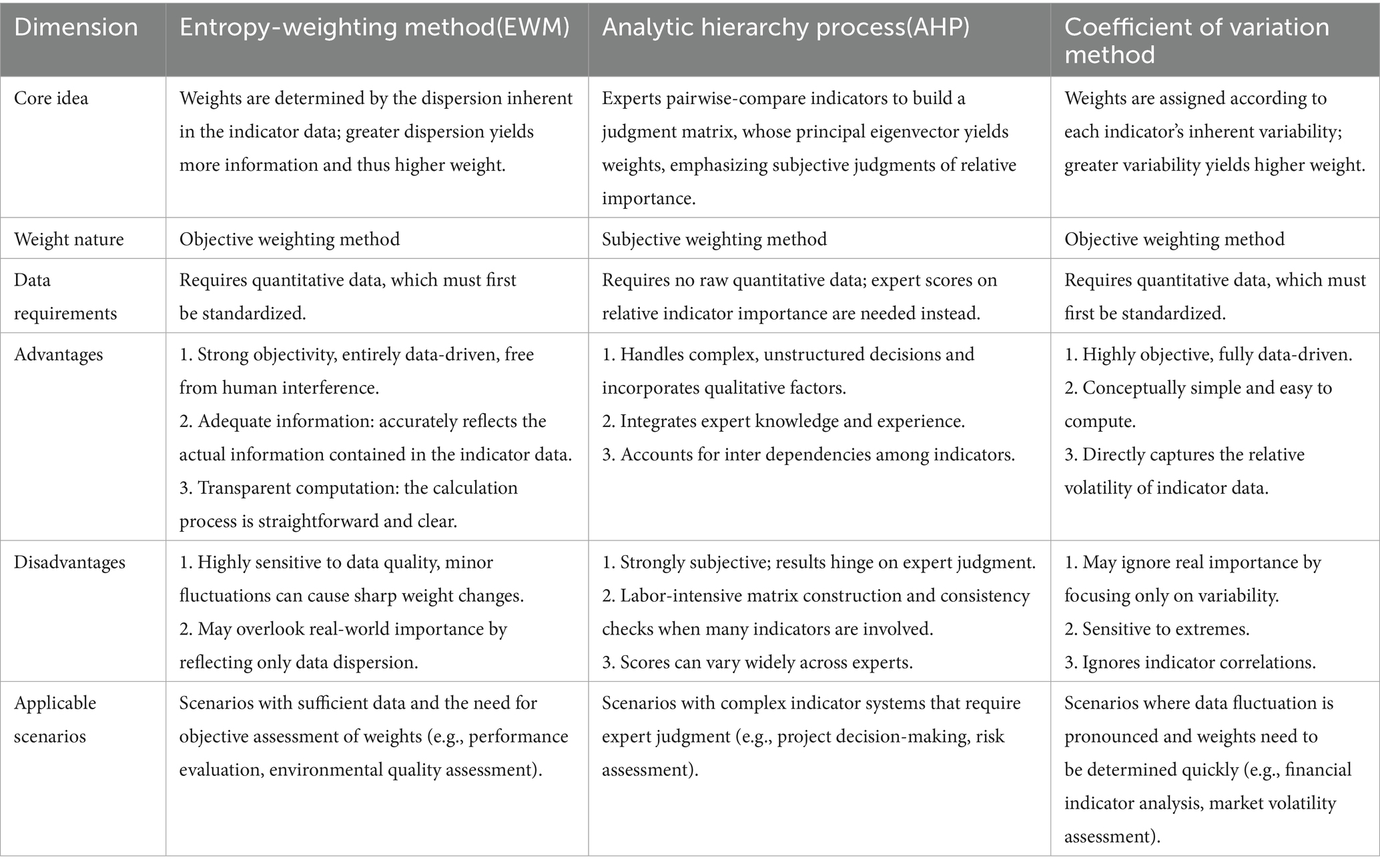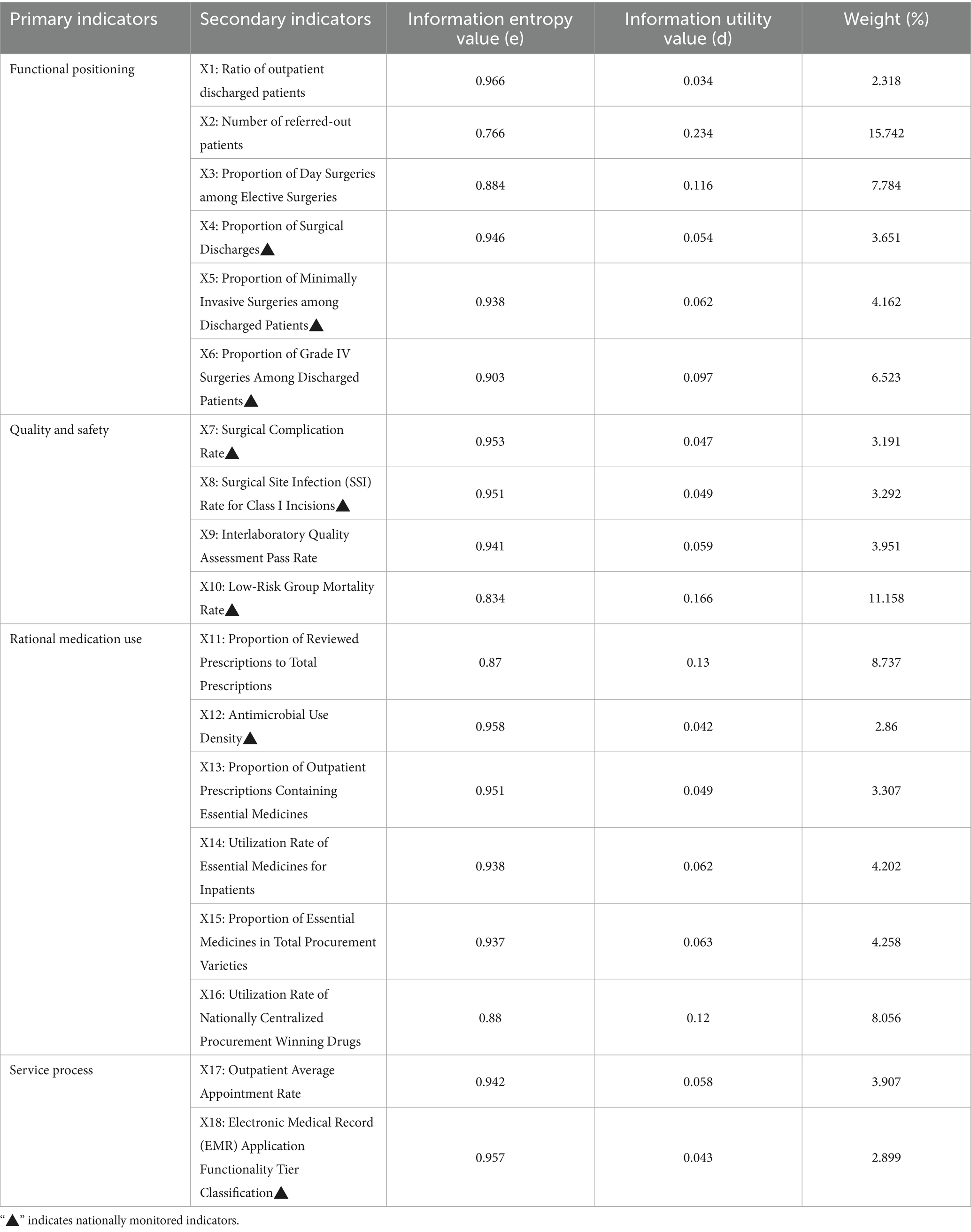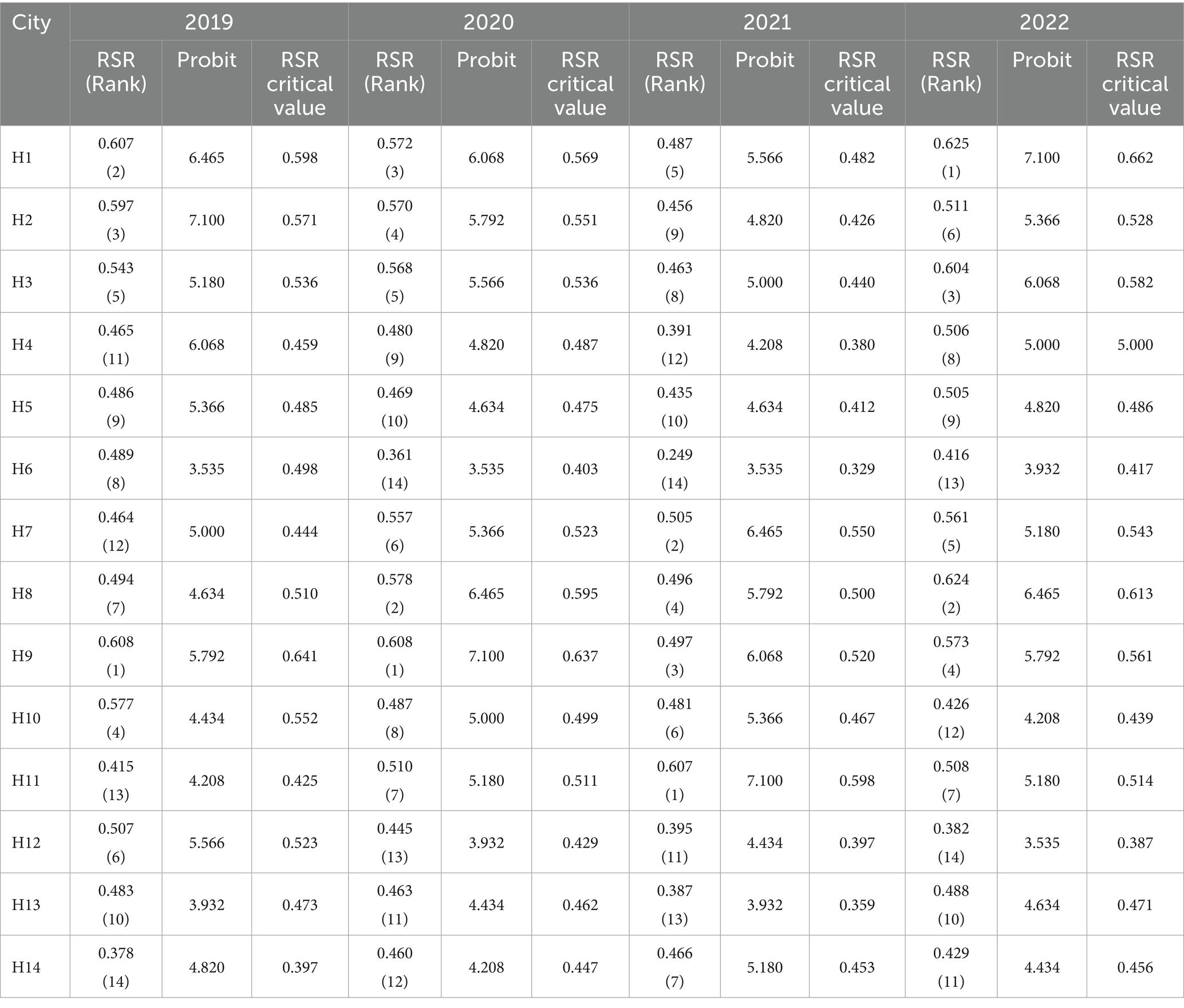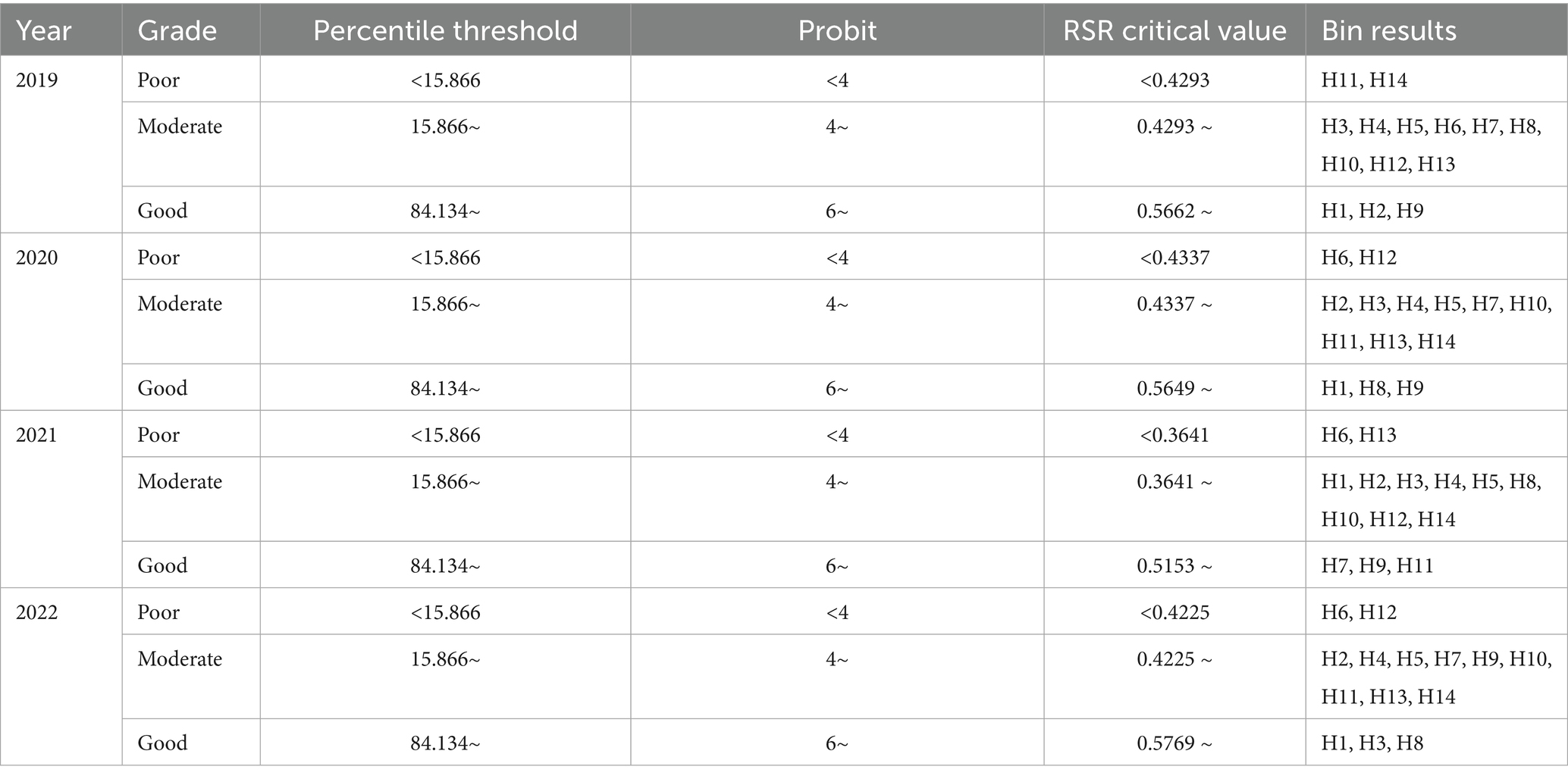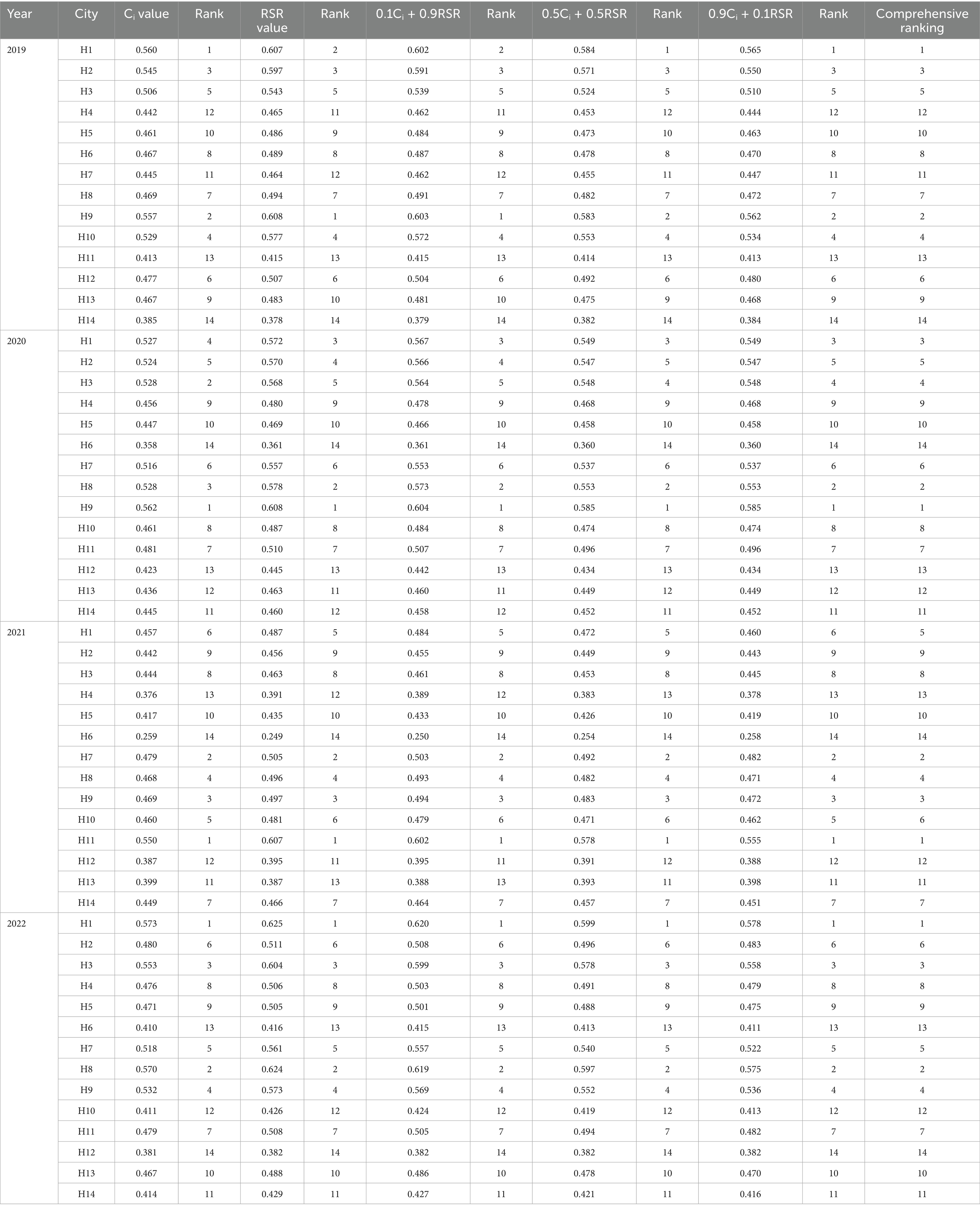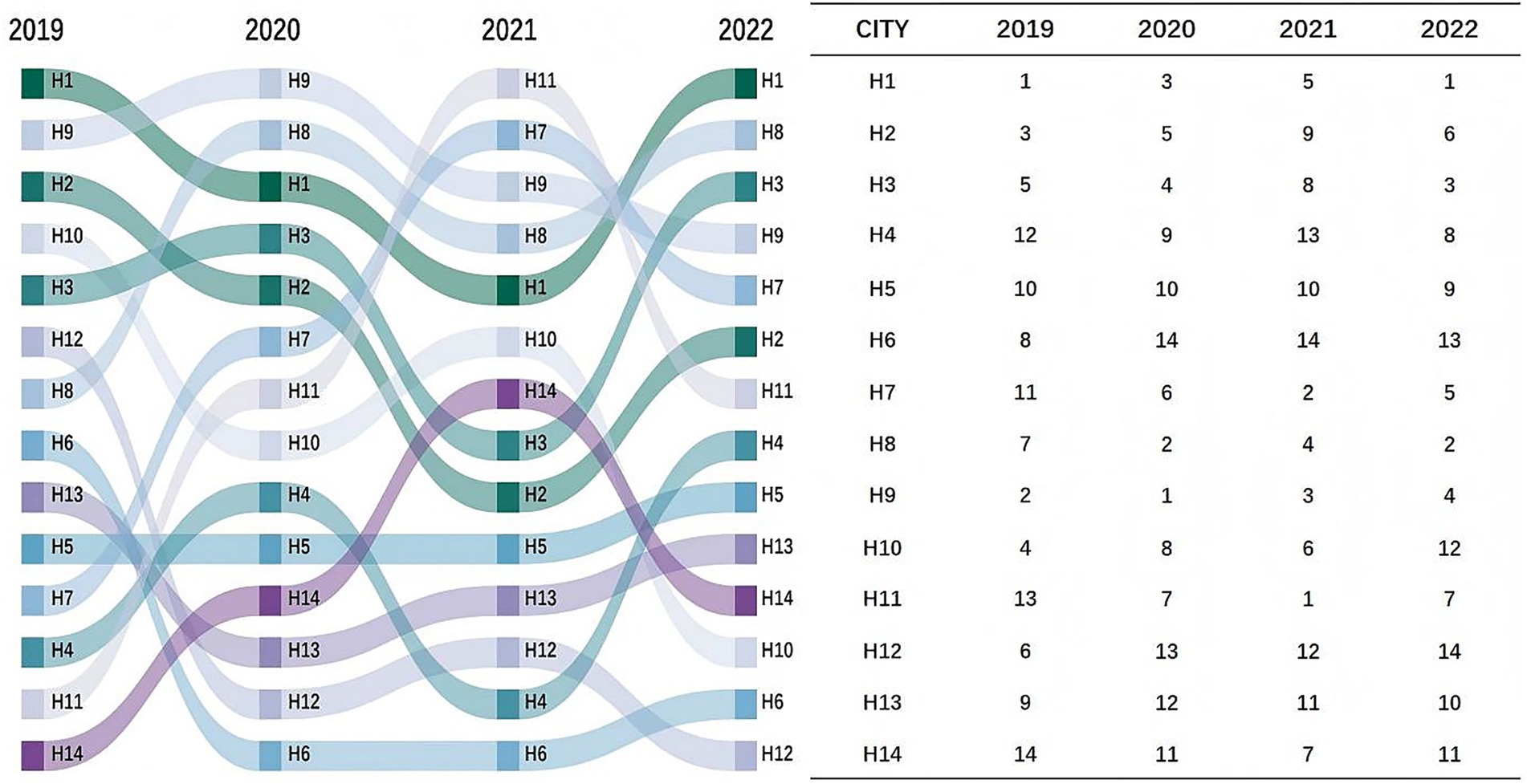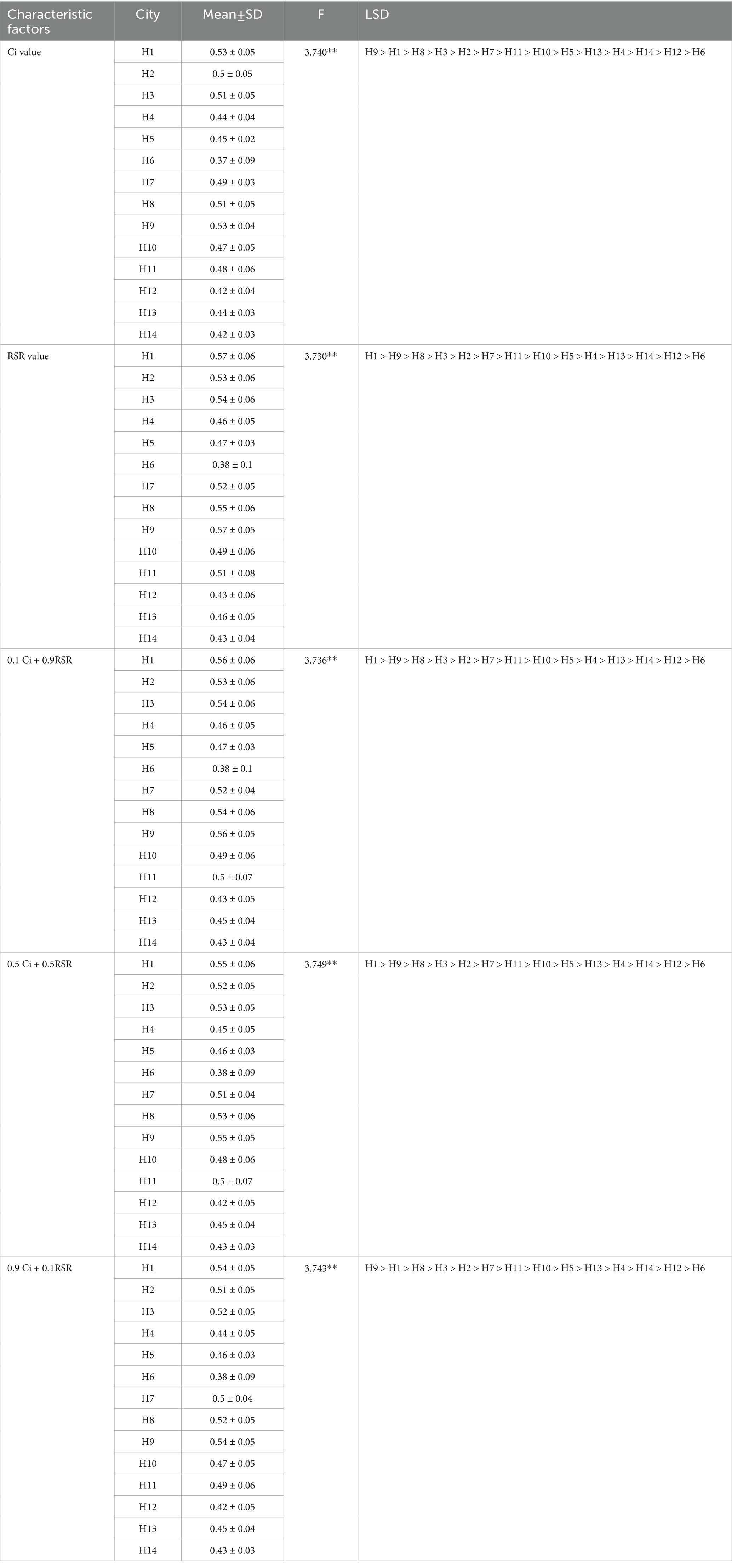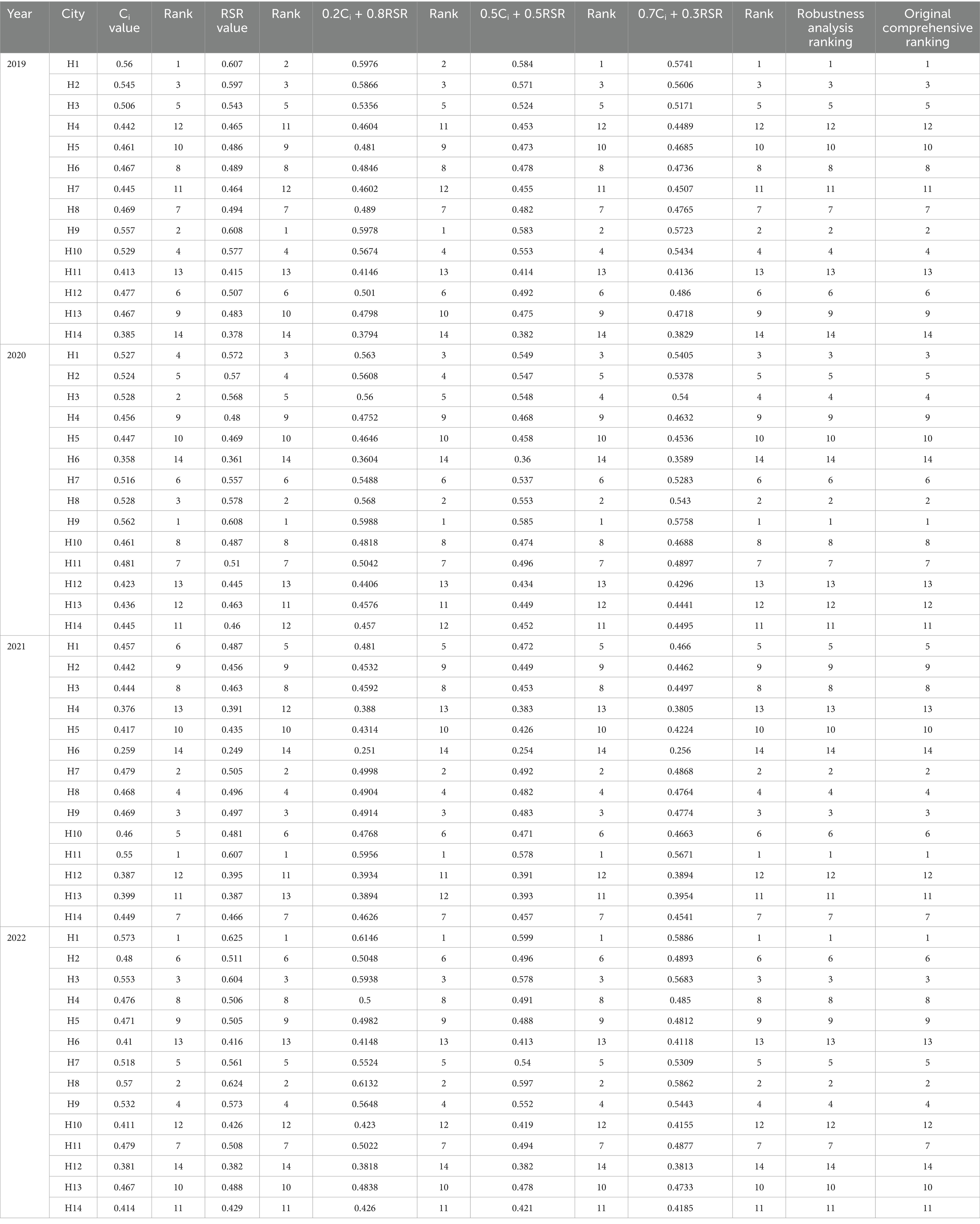- 1Guangxi International Zhuang Medical Hospital, Nanning, China
- 2The First Affiliated Hospital of Guangxi Medical University, Nanning, China
- 3Guangxi Zhuang Autonomous Region Medical Management Service Guidance Center, Nanning, China
- 4Liuzhou Municipal Liutie Central Hospital, Liuzhou, China
- 5School of Nursing, Guangxi Medical University, Nanning, China
Objective: Performance evaluation is critical for improving healthcare quality and service delivery. This study analyzes the healthcare quality of tertiary hospitals across various cities in Guangxi under China’s public hospital performance assessment policy to identify influencing factors and propose targeted improvement strategies for the national evaluation system.
Methods: The healthcare quality of general hospitals in Guangxi from 2019 to 2022 was evaluated using a fuzzy set entropy-weighted TOPSIS and RSR method, followed by a comprehensive city-level ranking.
Results: Entropy-weighted TOPSIS revealed the top three weighted indicators: (1) number of referred-out patients, (2) low-risk group mortality rate, and (3) proportion of reviewed prescriptions. The quality of H7 and H11 improved significantly, while H9 consistently ranked in the top 4. The RSR stratification classified H1, H2, H8, and H9 as high-performing, H6 and H12 as low-performing, and H4, H5, H6, H12, and H13 as persistently below average for four consecutive years. Using the fuzzy set method, H1, H9, H11, and H1 were ranked as the highest-performing cities from 2019 to 2022, respectively.
Conclusion: There are minor discrepancies among the three methodologies, but the trends remain largely consistent. The fuzzy-combined approach provides more robust evaluations, which offers actionable insights for healthcare quality enhancement and management standardization. Consequently, hospitals should improve the quality of services and sustain the core competitiveness of public hospitals by implementing tiered healthcare systems and standardized prescription review protocols.
1 Background
Healthcare quality is the key to the performance evaluation of tertiary hospitals. Management standards must be raised to foster ongoing improvements in healthcare quality and public service. In recent years, China has issued a series of important documents, including the “Guidelines for Strengthening the Performance Assessment of Tertiary Public Hospitals,” “Strategies for Promoting the High-Quality Development of Public Hospitals,” and “Announcement for Initiating a Comprehensive Campaign to Improve Healthcare Quality (2023–2025),” all of which underscore the critical importance of healthcare quality in public hospitals. Performance evaluation is not only a vital instrument for improving healthcare quality but also a cornerstone of the high-quality development trajectory and the modern management framework of public hospitals. Since 2009, China has been progressively developing theories and policies about the performance evaluation of public hospitals (1). The year 2019 witnessed the comprehensive implementation phase of performance evaluations in public hospitals (2). Concurrently, China introduced the “National Performance Assessment Manual for Tertiary Public Hospitals,” which appraises these institutions from four key dimensions: patient satisfaction, sustainable development, operational efficiency, and healthcare quality. The release of this manual signifies the first establishment of a cohesive national hospital performance assessment system in China. Healthcare Quality and patient safety constitute the bedrock of healthcare service (3). The performance evaluation of tertiary public hospitals prioritizes healthcare quality as the principal metric for assessments from four dimensions: role definition, service delivery, rational medication, and quality safety. These assessments aim to improve the management levels of healthcare institutions, enhance service delivery capabilities, protect public health rights and interests, and promote the high-quality development of the medical and health sector (4). The western regions of China are marked by a significantly smaller pool of healthcare resources and comparatively suboptimal hospital care quality. Guangxi ranks last among the six provinces of south-central China in terms of hospital beds, physicians, and nurses per 1,000 permanent residents. It has only 61,300 licensed physicians and ranks second to last in the size of the physician workforce, while its 1,481 comprehensive ICU beds fall short of Henan (the top-ranked province) by 4,343 beds. Similarly, other western autonomous regions—Xinjiang, Ningxia, and Tibet—perform poorly in their respective regional ranking (5). Moreover, multilingual ethnic settings and cross-border patient flows present additional challenges to healthcare delivery in these border minority areas. Addressing the challenge of how to meet the growing public health demands with these limited resources, while simultaneously advancing healthcare reforms through internal management system innovation, strengthening operational management, and improving care quality and equity in resource allocation, has become a major issue in China’s health management field. Resolving these issues is not only crucial for health improvements but also holds substantial significance for ethnic unity, making it a focal point of joint research attention in both academic and political circles in China (6).
1.1 Regarding the relationship between the quality of healthcare and the burden of medical expenditure
Studies have consistently shown that patients move to higher quality regions when local care quality cannot meet demands. Thorsen et al. found that higher severity strongly predicts travel to advanced hospitals (7). Xu et al. observed that migrants gravitate toward cities rich in tertiary centers (8). The 2021 Statistical Bulletin of China’s Medical Security Development reported that 162.7 million of 1.53 billion insured inpatient episodes occurred outside the home prefecture of patients, accounting for 10.6% of cases and 23.3% of inpatient expenditure. Thus, cross regional care incurs substantially higher costs per admission than local care.
1.2 Regarding the relationship between performance evaluation and healthcare quality improvement
China’s 2019 “Guidelines on Strengthening Performance Assessment of Tertiary Public Hospitals” explicitly stipulate that the evaluation results serve as the key determinants for government funding allocation, medical insurance reimbursement, total performance-based compensation, and remuneration, appointment, and disciplinary measures of hospital executives, along with a close combination of hospital accreditation and merit-based awards. Duan et al. conducted an in-depth analysis of the impact of performance evaluation systems on quality management. This revealed post-implementation improvements, including a 6.48% increase in Tier III and IV surgical procedures, 26.67 and 13.64% reductions in elective surgery complication rates and Class I incision infection rates, respectively, which demonstrated significant enhancements in operational efficiency and service quality (9). Wang Y further observed substantial policy effects, with a significant reduction in the intensity of antibiotic usage, a 20% reduction in outpatient waiting time, and a measurable improvement in patient satisfaction scores after the reform (10).
1.3 Regarding the application of healthcare quality assessment methodologies
The TOPSIS (Technique for Order Preference by Similarity to Ideal Solution) was first proposed by C. L. Hwang and K. Yoon in their seminal work Multiple Attribute Decision Making: Methods and Applications (1981). This method ranks alternatives by calculating their relative proximity to both ideal and negative-ideal solutions. Originally applied in marketing and business management, it has been subsequently adopted for health system evaluations. Notable applications include Wu XL and Liang Mingbin’s development of quality assessment criteria for cancer pain clinic records using TOPSIS-based weighting (11), and Beata Gavurova’s comparative analysis of health well-being across EU nations (12). The Rank Sum Ratio (RSR) method, introduced by Chinese statistician Professor Tian F in 1988, integrates nonparametric statistics with comprehensive evaluation (13). Its core mechanism involves rank transformation of raw data followed by RSR computation, enabling multidimensional assessment and ranking. This approach has gained particular prominence in healthcare quality evaluation (14). Representative applications include Wu et al.’s comparative evaluation of child healthcare services in China (15) and Liu’s maternal health service assessments using national health statistical yearbook data (16).
This study is the first to evaluate the healthcare quality levels of hospitals in western China by integrating the performance appraisal indicators of national tertiary public hospitals. Specifically, the contribution of this study is as follows: First, although existing studies have applied TOPSIS or RSR models to evaluate public hospitals, most have focused more on individual departments or hospitals. Different from other papers, this study assesses the healthcare quality levels of tertiary public hospitals in Guangxi from a city-to-city ranking perspective. This approach helps various cities to pinpoint weak links in healthcare quality management and prioritize areas for improvement. It also provides a scientific basis for local health administrative departments to analyze the current state of healthcare quality in tertiary general hospitals and to formulate national examination quality improvement plans. Second, in terms of model selection, TOPSIS and RSR models are integrated with the fuzzy set theory in a fuzzy union to derive a comprehensive ranking. Hence, the limitations of using a single evaluation method can be mitigated effectively.
2 Materials and methods
2.1 Data source
The data of this study are obtained from statistical and financial reports of 58 tertiary public hospitals in Guangxi from 2019 to 2022. Among them, there are 17 hospitals at the regional level, 36 at the municipal level, and 5 at the county level. Hospitals from different cities are categorized and integrated to encode 14 cities in the order of H1-H14.
2.2 Methods
2.2.1 Evaluation indicators
The healthcare quality of tertiary public hospitals in Guangxi is evaluated according to the “National Tertiary Public Hospital Performance Assessment Manual (2024 Edition)” and relevant literature findings, which focus on four dimensions: service process, rational medication, quality safety, and functional positioning. Functional positioning requires tertiary hospitals to implement tiered diagnosis and treatment systems and to play a core role in regional healthcare, which reflects the hospital’s ability to treat critically ill patients and perform complex and highly challenging surgeries (17, 18). Quality safety, as the cornerstone of healthcare quality, is directly related to the health and well-being of the public. Rational medication, as a key aspect of healthcare quality supervision, fully embodies the functional positioning and public welfare nature of public hospitals (19). The service process is mainly assessed based on patient experience and the hospital’s level of informatization to evaluate the effectiveness of service improvement.
Following the principles of systematicity, scientificity, dynamism, availability, and policy orientation, this study ultimately constructs a healthcare quality evaluation index system for tertiary public general hospitals in Guangxi, including 18 secondary indicators (20–24), and assigns values to X1, X2, and X18 accordingly. The indicators X1-X6 reflect the hospital’s functional positioning and evaluate its role in the tiered healthcare delivery system. X7-X10 demonstrate clinical performance, X11-X16 effectively assess pharmaceutical management practices, while X17 and X18 measure patient service efficiency (Table 1).
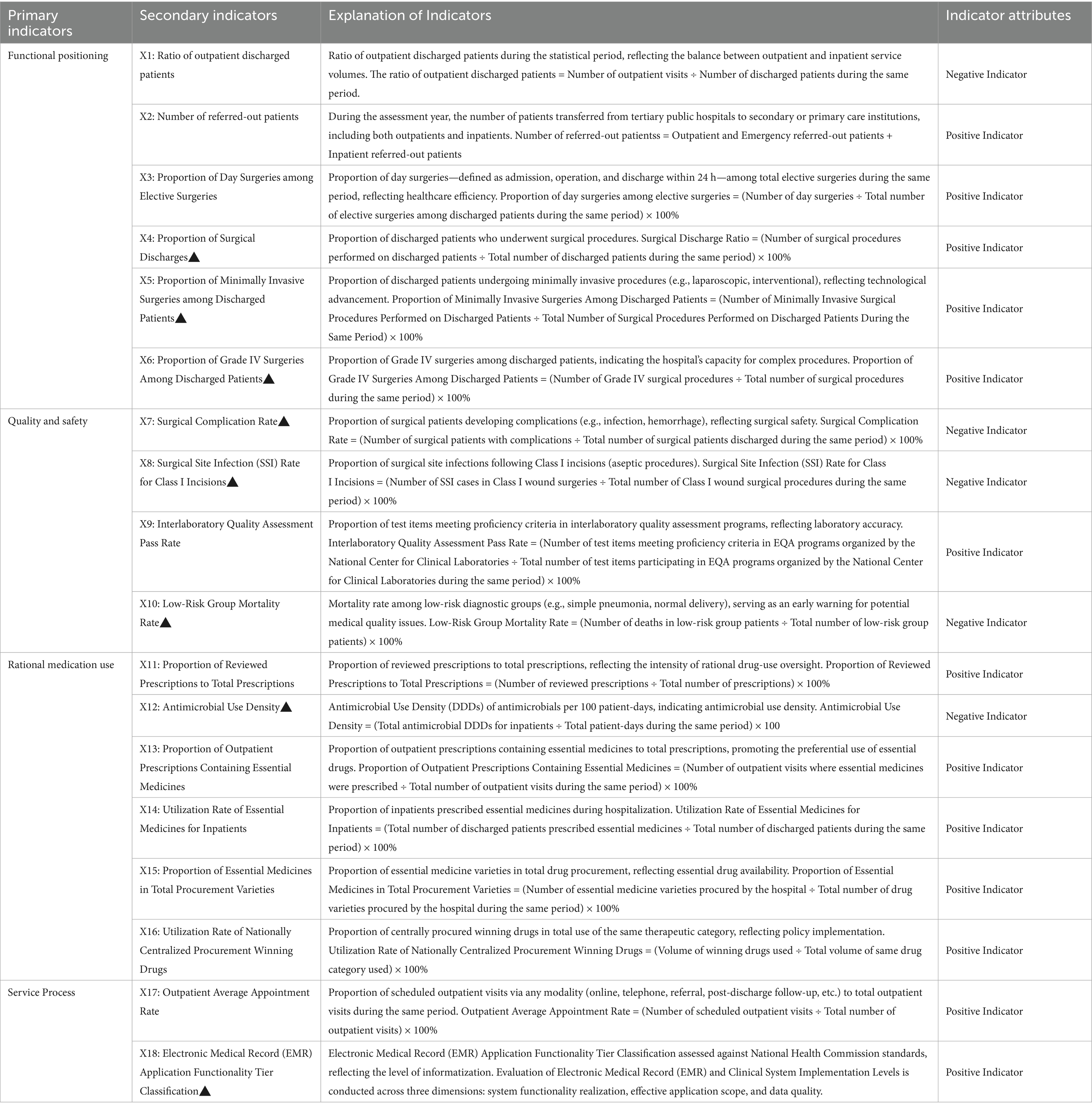
Table 1. Healthcare quality evaluation indicator system for tertiary public general hospitals in Guangxi.
2.2.2 Selection of indicator-weighting methods
Scholars have adopted various methodologies, such as the analytic hierarchy process and the coefficient of variation method, to determine the weights of indicators. Through a comprehensive literature review, the fundamental principles and relative strengths/limitations of the relevant models were analyzed, and the findings are summarized in Table 2 (25–29).
2.2.3 Entropy-weighted TOPSIS method
The entropy-weighted TOPSIS method combines the TOPSIS method and the entropy-weighted method. The entropy-weighted method employs standardized processing and objective weight determination to avoid human interference (30). The TOPSIS method ranks alternatives according to their distance from the ideal solution (31, 32). Zhou et al. applied entropy weight method (EWM) and fuzzy logic to identify key pollution parameters in water quality assessment, where indicator weights determined remediation priorities (33). Oluah et al. utilized entropy-weighted TOPSIS to establish thermal conductivity as the primary performance-limiting factor for phase-change materials in Trombe wall applications (34). Similarly, Zhan et al. employed entropy-weighted TOPSIS to reveal significant spatial distribution imbalances among tertiary hospitals in China’s Xinjiang region (35). In this study, the entropy-weighted TOPSIS method was used via STATA 17.0 to comprehensively evaluate healthcare quality data across different cities from 2019 to 2022. Data organization and preliminary calculations were performed using Excel 2021. The computational steps are as follows:
① The accurate original matrix X = (Xij) n × m (where i = 1,2,…,n; j = 1,2,…,m), where Xij is the value of the j-th indicator for the i-th object (36), m is the number of indicators, and n is the number of objects. For the five negative indicators: ratio of outpatient discharged patients, surgical complication rate, surgical site infection rate for class I incisions, low-risk group mortality rate, and antimicrobial use density, standardized values were obtained through range normalization. Specifically, Zij+ represents the normalized score for positive indicators and Zij− for negative indicators, yielding the standardized matrix Z. The electronic medical record application functionality tier classification by Yang et al. (37) involves multiplying the level by 10 to better assess the service process in tertiary general hospitals.
② Calculate the weight Pij, the entropy value ej, the difference coefficient dj, and the weight wj.
③ Construct the weighted TOPSIS matrix by multiplying each column of the normalized matrix Z with its corresponding weight; calculate the positive ideal solution Z+ and the negative ideal solution Z−; compute the Euclidean distance from each object to the positive ideal solution Di+ and to the negative ideal solution Di−; compute the relative closeness Ci, with 0 ≤ Ci ≤ 1, where a higher Ci value is better.
2.2.4 RSR model
The RSR (Rank-Sum Ratio) method is extensively applied in the medical and health field (38–40) for ranking and grading through rank transformation to obtain dimensionless statistical quantities. In this study, the comprehensive development level of healthcare quality Ci from 2019 to 2022 in each city is used instead of the RSR value. The RSR method is used to rank and grade the subjects using Excel 2021 and STATA 17 software. The computational steps are as follows:
① Prepare an n × m original matrix, where n represents the number of objects and m represents the number of indicators. Rank the indicators from smallest to largest according to the RSR method to calculate the rank matrix R, where a higher rank indicates better performance.
② Calculate the RSR value.
③ Construct the RSR frequency distribution. List the frequency for each group, compute the cumulative frequency for each group, calculate the rank range and average rank for RSR, compute the cumulative percentage (with the last item recorded as for correction), and calculate the probit value (the cumulative frequency plus 5 to obtain the standard normal deviation ).
④ Calculate the linear regression equation. The RSR value represents the dependent variable. The probit value represents the independent variable, which corresponds to the cumulative frequency in probability units. The linear regression equation is calculated through the least square method, that is:
⑤ Conduct the regression equation test and obtain the estimated RSR values by running the regression equation, followed by grading and ranking of these values.
2.2.5 Fuzzy set of entropy-weighted TOPSIS and RSR methods
To ensure the scientific nature of this study, the fuzzy set theory (41) is employed to perform a fuzzy union using the entropy-weighted TOPSIS and RSR methods. Generally, the weight ratio (W1: W2) is taken as 1:0, 0:1, 0.1:0.9, 0.5:0.5 and 0.9:0.1 (42), which indicates that the W1Ci × W2RSR value is calculated and ranked, where W1Ci × W2RSR ∈ (0, 1). The values closer to 1 indicate better results (43).
3 Results
3.1 Evaluation results using the entropy-weighted TOPSIS method
After standardizing indicators and performing normalized calculations, Table 3 displays the weighting of healthcare quality evaluation indicators. The four dimensions of healthcare quality indicators are weighted as follows: Functional Positioning (40.18%) > Rational Medication (31.42%) > Quality and Safety (21.592%) > Service Process (6.806%). Among the evaluation indicators, the top three are X2: number of referred-out patients (15.742%), X10: low-risk group mortality rate (11.158%), and X11: proportion of reviewed to total prescriptions (8.737%). The X2 serves as a core indicator for evaluating the implementation effectiveness of the tiered diagnosis and treatment policy, effectively highlighting hospitals’ functional positioning. The X10 represents a critical metric for healthcare safety that directly reflects institutional care quality. Meanwhile. The X11 establishes a robust medication safety safeguard by compelling hospitals to optimize the closed-loop process of “prescription review-evaluation-feedback-re-review.” The smallest weight is X1: Ratio of outpatient discharged patients (2.318%), as detailed in Table 3.
The evaluation results indicate significant fluctuations in the Ci ranking among various cities over the observed period. Overall, the average Ci values from 2019 to 2022 were 0.48, 0.478, 0.433, and 0.411, respectively. Regions that failed to reach the average for four consecutive years included H4, H5, H6, H12, and H13, which suggested that the levels of healthcare quality in these areas require improvement. From a micro perspective, H1 returned to the forefront in 2022 after 2 years of fluctuating decline. H9 consistently ranked in the top 4 over the 4 years. H6 has been ranked at the bottom since 2019. The healthcare quality of H7 and H11 improved significantly, from 11th and 13th in 2019 to 5th and 7th in 2022, respectively. The healthcare quality of H10 and H12 declined significantly, each regressing by 8 places compared to 2019, as detailed in Table 4.
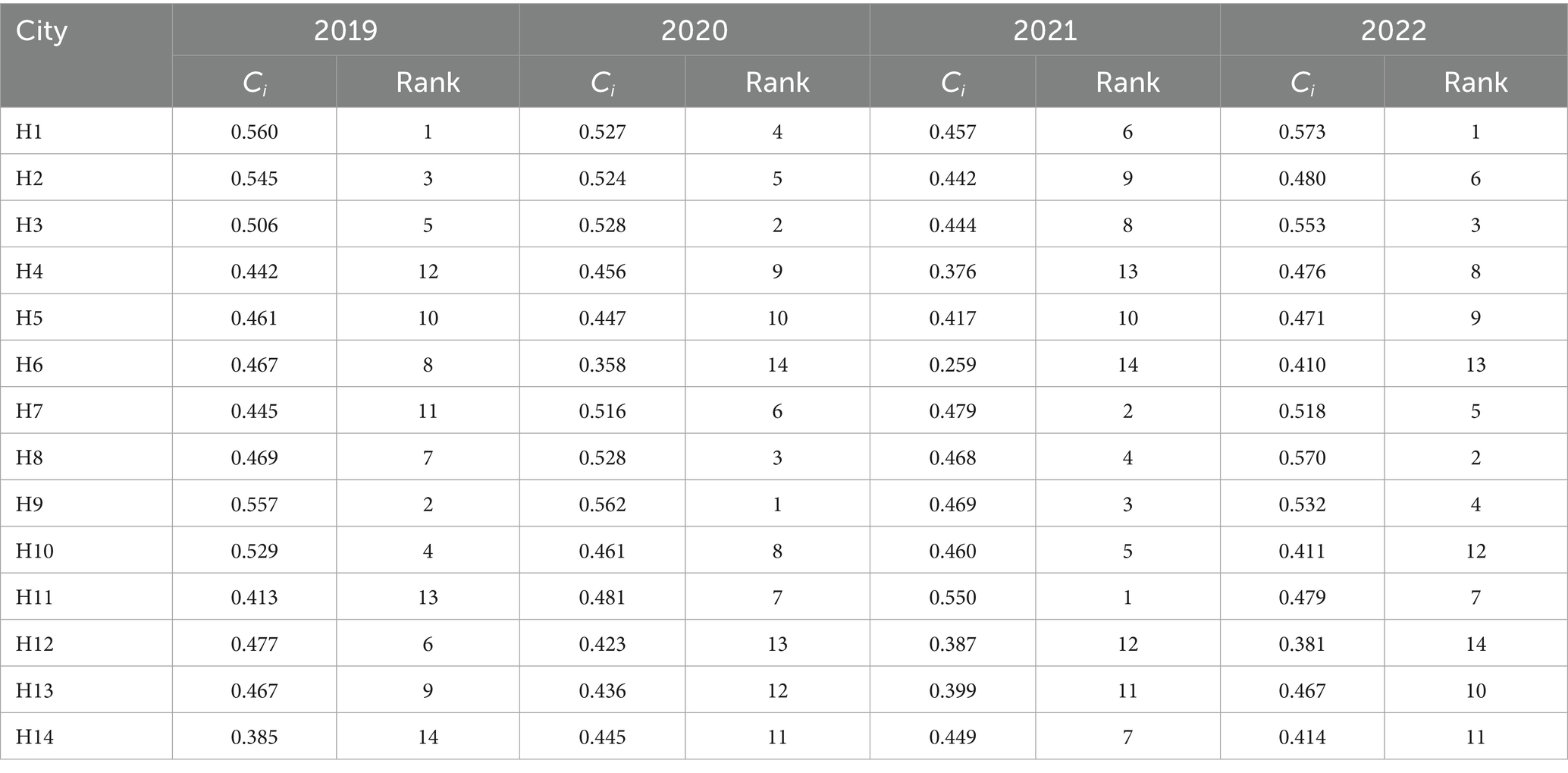
Table 4. Evaluation results of the relative closeness ci to healthcare quality in various cities of Guangxi from 2019 to 2022.
3.2 RSR evaluation results
The departments were ranked by order to display the standings of various regions under the healthcare quality evaluation indicators. The average RSR values of Guangxi from 2019 to 2022 were 0.508, 0.509, 0.451, and 0.511, respectively. The regions that failed to reach the average for four consecutive years were H4, H5, H6, H12, and H13, which is consistent with the results of the TOPSIS method. In terms of healthcare quality, the city that ranked first in both 2019 and 2020 was H9, while those that ranked first in 2021 and 2022 were H11 and H1, respectively. The most significant improvement in healthcare quality was seen in H7, which elevated 7 places in the ranking from 2019 to 2022 and now stands at 5th in Guangxi. See Table 5 for details.
According to the optimal grading principle of the RSR method (44), the medical development levels of various cities from 2019 to 2022 were categorized into three grades: good, moderate, and poor. The grading results are shown in Table 6. In each year, there were 2 cities with poor levels, 9 cities with moderate levels, and 3 cities with good levels.
3.3 Fuzzy set evaluation results
The fuzzy set theory (FST) was used to integrate the entropy-weighted TOPSIS and RSR methods to ensure the scientific validity of the results in this study. From 2019 to 2022, the healthcare quality of tertiary public hospitals in Guangxi was evaluated across five grading categories. The results of the Ci and RSR values will not be repeated here. Under the weight of 0.1Ci + 0.9RSR, the top-ranked city of both 2019 and 2020 was H9, and those of 2021 and 2022 were H11 and H1, respectively. The ranking results were consistent under the weights of 0.5Ci + 0.5RSR and 0.9Ci + 0.1RSR. The top-ranked cities over the 4 years were H1, H9, H11, and H1, respectively. Following the “more is better” principle, the comprehensive ranking of all cities was determined (45). The top-ranked cities from 2019 to 2022 were H1, H9, H11, and H1, respectively. For detailed results, see Table 7 and Figure 1.
3.4 Validation
To demonstrate the differences in healthcare quality evaluation among the 14 cities, we performed an analysis of variance (ANOVA) on the evaluation scores derived from the TOPSIS, RSR, and Fuzzy methods. The results showed that the p-values for all five sets of evaluation scores were less than 0.01, indicating statistically significant differences in healthcare quality assessments. See Table 8 for details. To ensure robustness, the fuzzy-set method was subjected to a sensitivity test. The original weights were perturbed by replacing the combination of 0.1 Ci + 0.9RSR and 0.9 Ci + 0.1RSR with 0.2 Ci + 0.8RSR and 0.7 Ci + 0.3RSR, respectively, and 14 cities were re-ranked accordingly. The resulting rankings remained identical to those produced by the FUZZY STE model, which confirmed its reliability (Table 9).
4 Discussion
4.1 The rationality of using a fuzzy set of entropy-weighted TOPSIS and RSR
Entropy-weighted TOPSIS and the RSR method are widely used in health management. Relying on a single evaluation technique, however, inevitably introduces limitations that can distort the results (46). Entropy weighting objectively quantifies the relative importance of each indicator and avoids subjective bias (47). TOPSIS quantifies the distance between each alternative and the positive and negative ideal solutions, thereby capturing differences among schemes and enhancing reliability. Yet this approach is sensitive to extreme values and struggles to convey the differential impact of individual indicators (48). Chenghui et al. incorporated deliberately extreme values into real operational data from 24 tertiary hospitals and observed that TOPSIS misclassified three hospitals (49). The RSR method, which uses ranks rather than raw values, effectively dampens the influence of outliers and highlights minor fluctuations, but the ranking process discards metric information and weakens data utilization, this limitation also emerged in our study, as the stratification failed to reflect subtle shifts in the RSR values across cities (Table 6). To address the limitations of using the TOPSIS or RSR method alone, this study employs the fuzzy set theory to perform a fuzzy integration of the two methods. Based on the weight ratios of 1:0, 0:1, 0.1:0.9, 0.5:0.5, and 0.9:0.1, this study ranks various cities in Guangxi across different years. The final ranking is determined using a comprehensive evaluation approach based on the “majority principle.” This method not only takes full advantage of the raw data but also mitigates the impact of outliers, which enhances the reliability and accuracy of the evaluation results.
4.2 The issue of unbalanced healthcare quality levels across various cities in Guangxi becomes prominent
This study calculated the mean values across five weight ratios—1:0, 0:1, 0.1:0.9, 0.5:0.5, and 0.9:0.1—over 4 years and determined the proportion of hospitals that failed to meet the average values. In the TOPSIS evaluation model, the proportion of cities that failed to reach the mean values from 2019 to 2022 was 64.29, 50, 35.71, and 64.29%, respectively. In the RSR model, the proportion of cities below the average was 64.29, 50, 35.71, and 57.14%, respectively. The results calculated under the weight ratio of 0.1Ci + 0.9RSR were consistent with the RSR model. Under the weight ratio of 0.5Ci + 0.5RSR, the proportion of cities that failed to reach the average was 57.14, 50, 35.71, and 57.14%, respectively. The results under the weight ratio of 0.9Ci + 0.1RSR were consistent with the TOPSIS model. It is evident that, except for 2021, more than 50% of the cities did not meet the average standard in other years. In the evaluation model, the values of the top-ranked cities were more than double those of the lowest-ranked cities, which indicated a significant imbalance in the development of healthcare quality levels in Guangxi. H1, H2, H8, and H9 achieved better rankings, while H6 and H12 ranked relatively behind. The reasons included Guangxi’s relatively weak economic foundation, differences in population size, economic development levels of various regions, and health financial investment, which certainly led to disparities in healthcare quality levels. In 2021, there was a drastic change in the ranking of cities across Guangxi, since the region was in a critical phase of epidemic prevention and control. Additionally, labor expenses of medical staff, consumption of protective materials, tasks of nucleic acid testing, and responsibilities for epidemic prevention and control varied across hospitals at different levels. Areas with higher healthcare quality levels also undertook heavier tasks of epidemic prevention, and these external factors affected the development of local healthcare quality to varying degrees. H8, with only three tertiary hospitals, still achieved a better grade, which demonstrated that while focusing on external conditions, hospitals must also identify their own positioning and development direction (50). Cities H7 and H11 demonstrated consistent upward trends in healthcare quality indicator rankings during the four-year period, which prompted the targeted investigation. H7 implemented the “Implementation Plan for High-Quality Development of Public Hospitals,” requiring that all the municipal tertiary public hospitals improve the national performance evaluation ranking by at least 100 positions. Notably, H7 was one of the first cities in Guangxi to adopt the innovative “1 + N dynamic performance salary allocation mechanism.” These policy interventions collectively contributed to significant improvements in H7’s healthcare quality metrics. In-depth analysis of poorly-performing cities H6 and H12 revealed three common deficiencies. First, jurisdictions experienced severe underinvestment: H6’s healthcare project expenditure fell by 35% between 2020 and 2022, while H12’s health budget was only 73% of the Guangxi average. Second, the staff shortage was severe. In 2022, H6 had 443 unfilled posts, 80% of which were in imaging, anaesthesiology and critical care, while H12 lost 92 senior professionals between 2020 and 2022. This made the anaesthesiologist number below the national baseline for tertiary hospitals. Third, digital maturity lagged: none of H6 hospitals achieved Level 4 EMR capability, and H12’s tertiary hospitals had the lowest DRG upload completeness at 72%. Consequently, both municipal governments should increase fiscal commitments to health, accelerate information-system upgrades, and cooperate with universities to break disciplinary silos, strengthen professional capacity, and reduce patient outflow, while simultaneously securing a larger and more stable health workforce. Cities with poor performance in healthcare quality should fully leverage the targeted support of the State Ethnic Affairs Commission, utilize the strengths of their paired tertiary hospitals, and pursue cross-border cooperation with neighboring countries.
4.3 The indicators of “functional positioning” and “rational medication” affect healthcare quality
In the dimensions of healthcare quality assessment, the primary indicators with higher weights are functional positioning and rational medication, with weights of 40.18 and 31.42%, respectively. Among the secondary indicators, the top three are X2: number of referred-out patients (15.742%), X10: low-risk group mortality rate (11.158%), and X11: proportion of reviewed to total prescriptions (8.737%). X2 and X11 are the high-weight primary indicators, while X10 pertains to quality and safety. This suggests that when cities focus on high-weight primary indicator groups, they must also balance the advancement of other significant indicators. The survey samples consist exclusively of tertiary and above general hospitals. Functional positioning is primarily focused on the treatment of critically ill patients and complex medical conditions (51). Data from field research indicate that regions categorized as “good” have a concentration of superior medical resources and exert a significant gravitational pull on patients from surrounding cities. These areas have an adequate number of patients to adjust treatment structures, which allows hospitals to focus on complex regional diseases, enhance service provision, and improve indicators such as “proportion of surgical discharges,” “proportion of minimally invasive surgeries among discharged patients,” and “proportion of grade IV surgeries among discharged patients”. Regions with a “moderate” level possess a certain volume of healthcare resources that can cover common diseases and treatment needs for more challenging surgeries. These areas should ensure basic medical service provision while expanding the scope of medical service, which may optimize service structures and increase the supply of specialized medical services to meet patients’ diverse and personalized healthcare needs. Compared to the aforementioned regions, areas with a “poor” level still have a gap in healthcare service provision, with deficiencies in complex surgeries, rare disease treatment, and high-end medical services. It is recommended that these areas should strengthen the construction of key medical disciplines and specialties, create advantageous specialties, enhance the brand influence of hospitals, and focus on tackling prevalent and frequently referred diseases to improve core competitiveness. Additionally, hospitals should also respond to the construction of a medical consortium, implement a tiered diagnosis and treatment system, and facilitate the downward transfer of high-quality medical resources. With a focus on the treatment of complex and acute-phase diseases, common, frequent, and stable or recovery-phase patients can be gradually transferred downward through the “urgent and chronic disease separation, upward and downward linkage.” The aim is to enhance the efficiency of medical resource utilization and clarify the positioning of tertiary public hospitals, which thus enhances the development level of functional positioning. On the other hand, to promote the transformation of pharmaceutical service models, all tertiary hospitals should standardize prescription review management systems, regularly organize special groups to review prescriptions and medical orders, and involve physicians, pharmacists, nurses, and patients in the medication process. In 2022, the 25th percentile, median, and 75th antimicrobial use density across various cities in Guangxi were 36.005, 36.875, and 38.538, respectively. Regions with a “poor” level performed better in controlling antibiotic use, and H12 had the best value of 32.87 in the entire region. In contrast, regions with a “good” level had a value of 36.65 exceeding both the median and average values of Guangxi. It is recommended that these areas reasonably increase the proportion of basic medication use and standardize medication practices. Additionally, irrational prescriptions should be identified through a combination of big-data intelligent review and manual review. The intervention and follow-up management of over-prescribed medications is also required to ensure clinical medication safety (52).
5 Limitations
There are several limitations of this study. Firstly, the data obtained span a relatively short period only from 2019 to 2022. However, the results are still useful for assessing the development of healthcare quality levels across various cities. In the future, it is necessary to monitor data over additional years for further validation. Secondly, the use of the entropy-weighted TOPSIS and RSR methods for objective weighting of evaluation indicators may, to some extent, overlook the inherent importance of the raw data and the indicators themselves, which leads to potential biases. However, the fuzzy integration of the two methods can help mitigate such an impact to a certain degree. Thirdly, the evaluation is limited to tertiary public hospitals in Guangxi and then restricts the generalizability of the results. Although such limitations are common in research, hospitals from Guangxi are fortunately included in this study. Besides, Guangxi is representative of western China at the average levels of economic and social development. Hence, the results of this study are still applicable to the actual situations of various cities in western China.
6 Conclusion
Using the fuzzy set of entropy-weighted TOPSIS and RSR methods, this study evaluates the healthcare quality levels of 59 tertiary public hospitals in Guangxi from 2019 to 2022 and analyzes the ranking of healthcare quality across 14 prefecture-level cities. There are significant fluctuations in healthcare quality across different years but with a relatively stable healthcare quality. The evaluation results of healthcare quality in different regions using the entropy-weighted TOPSIS and RSR methods are scientifically reliable. Efforts to enhance the healthcare quality of tertiary hospitals across various cities in Guangxi should focus on the indicators of “Quality and Safety” and “Rational Medication.” Hospitals are encouraged to actively respond to the tiered diagnosis and treatment system, comply with national policies, standardize the prescription review management system, ensure the safety of clinical medication, and improve healthcare quality levels to maintain the core competitiveness of public hospitals.
Data availability statement
The raw data supporting the conclusions of this article will be made available by the authors, without undue reservation.
Ethics statement
This study was approved by the Medical Ethics Committee of Guangxi Medical University (KY20250216). All methods were carried out in accordance with the Declaration of Helsinki and approved by the Ethics Committee. Written informed consent has been obtained from all participants.
Author contributions
JH: Conceptualization, Data curation, Formal analysis, Funding acquisition, Investigation, Methodology, Project administration, Resources, Software, Supervision, Validation, Visualization, Writing – original draft, Writing – review & editing. YW: Conceptualization, Data curation, Formal analysis, Investigation, Methodology, Project administration, Software, Supervision, Writing – review & editing, Writing – original draft. HP: Formal analysis, Project administration, Resources, Supervision, Validation, Writing – review & editing. HY: Conceptualization, Investigation, Project administration, Resources, Software, Writing – review & editing. XL: Conceptualization, Formal analysis, Investigation, Software, Supervision, Validation, Writing – review & editing. HW: Formal analysis, Funding acquisition, Investigation, Methodology, Software, Validation, Visualization, Writing – original draft. PZe: Methodology, Software, Supervision, Writing – review & editing. ZT: Conceptualization, Data curation, Investigation, Methodology, Resources, Software, Supervision, Writing – review & editing. PZh: Conceptualization, Data curation, Formal analysis, Funding acquisition, Investigation, Methodology, Project administration, Resources, Supervision, Writing – original draft, Writing – review & editing.
Funding
The author(s) declare that financial support was received for the research and/or publication of this article. This article has been significantly supported by the “Guangxi Natural Science Foundation Project (ID: 2023GXNSFAA026229),” the “National Health Commission Hospital Management Research Institute’s 2024 Healthcare Quality (Evidence-Based) Management Research Project (ID: YLZLXZ24G055),” and the “Guangxi Health Commission’s Entrustment Project (ID: Z-A20232064)”. The generous backing from these projects has been instrumental in facilitating the research presented in this manuscript.
Acknowledgments
Special thanks to Guangxi Medical Management Service Guidance Center for its support.
Conflict of interest
The authors declare that the research was conducted in the absence of any commercial or financial relationships that could be construed as a potential conflict of interest.
Generative AI statement
The authors declare that no Gen AI was used in the creation of this manuscript.
Any alternative text (alt text) provided alongside figures in this article has been generated by Frontiers with the support of artificial intelligence and reasonable efforts have been made to ensure accuracy, including review by the authors wherever possible. If you identify any issues, please contact us.
Publisher’s note
All claims expressed in this article are solely those of the authors and do not necessarily represent those of their affiliated organizations, or those of the publisher, the editors and the reviewers. Any product that may be evaluated in this article, or claim that may be made by its manufacturer, is not guaranteed or endorsed by the publisher.
References
1. Chen, Y, and Fan, Y. Review of performance assessment policies for public hospitals since the new medical reform. Chin Health Econ. (2018) 37:67–70.
2. Yao, D, Chu, S, Wang, D, Tang, Y, Liu, Z, and Mei, C. Analysis and reflection on the performance assessment policy of public hospitals in China. Chin J Health Qual Manage. (2021) 28:51–4.
3. Ma, XM. Discussion on healthcare quality indicators and related issues in the performance assessment index of tertiary public hospitals. Chin Hosp Manag. (2022) 42:49–52.
4. Shen, FH, Wang, XH, Yang, DD, and Song, HM. Study on the relationship between primary indicators in the performance assessment of tertiary public hospitals. Chin Health Econ. (2024) 43:63–6.
5. Hen, Y, Li, J, and Wang, X. Short-term allocation forecast of hospital health resources in China. Chin Health Resour. (2021) 24:453–7. doi: 10.13688/j.cnki.chr.2021.200805
6. Nong, Y, Zhang, X, and Xu, H. Operational efficiency and influencing factors of tertiary public hospitals in Hainan Province. Med Soc. (2024) 37:84–9. doi: 10.13723/j.yxysh.2024.02.014
7. Thorsen, ML, Harris, S, Palacios, JF, McGarvey, RG, and Thorsen, A. American Indians travel great distances for obstetrical care: examining ruraland racial disparities. Soc Sci Med. (2023) 325:115897. doi: 10.1016/j.socscimed.2023.115897
8. Xu, S, and Yin, J. Impact of direct settlement policies for cross-provincial medical care on healthcare utilization among floating populations. Chin J Popul Sci. (2025) 39:58–75.
9. Duan, S, Zhang, X, Yang, H, and Meng, W. Improving hospital quality management through performance assessment in tertiary public hospitals. Chin J Hosp Stat. (2021) 28:462–6.
10. Wang, Y. Implementation and benefit analysis of performance evaluation in top-tier public tertiary hospitals. China Chief Financ Officer. (2025) 2025:157–9.
11. Wu, XL, Liang, MB, Zhuang, XQ, Qin, HY, Qin, XF, Jia, JJ, et al. Establishment of quality evaluation criteria for outpatient medical records of cancer pain and assessment of its application effect. Zhonghua Yi Xue Za Zhi. (2022) 102:3115–20. doi: 10.3760/cma.j.cn112137-20220428-00952
12. Gavurova, B, and Megyesiova, S. Sustainable health and wellbeing in the European Union. Front Public Health. (2022) 10:851061. doi: 10.3389/fpubh.2022.851061
13. Tian, F. An attempt to apply the rank sum ratio method in factor analysis. Chin J Health Stat. (1995) 12:20–5.
14. He, LL, Yin, A, and Tian, Y. Application of RSR method for comprehensive evaluation of hospital medical work quality. Med Theory Pract. (2012) 25:1271–2.
15. Wu, M, Liu, Q, and Wang, Z. A comparative evaluation of child health care in China using multicriteria decision analysis methods. BMC Health Serv Res. (2023) 23:1217. doi: 10.1186/s12913-023-10204-4
16. Liu, Y, Yan, L, and Xia, Y. Evaluation of maternal health services in China using WHO's comprehensive assessment framework. BMC Health Serv Res. (2022) 22:1571. doi: 10.1186/s12913-022-08836-z
17. Wang, S, Sun, W, Huang, E, and Yuan, H. Application Reflections on the "Six Major Systems" for High-Quality Development of Public Hospitals: A Case Study of Peking Union Medical College Hospital. Chin Health Econ. (2023) 42:22–5.
18. Huang, Q, and Zheng, D. Discussion on performance assessment of public hospitals based on value-based healthcare orientation. Chin Health Econ. (2020) 39:75–9.
19. Xu, X, Liu, C, Wu, D, Chen, L, Liu, Y, Zhang, R, et al. Practice and exploration of performance assessment for rational drug use in public hospitals. Health Econ Res. (2022) 39:81–5.
20. Ma, L, Li, Y, Xue, J, Xu, L, Li, X, and Chang, X. Characteristics of healthcare quality in tertiary traditional Chinese medicine hospitals by TOPSIS and RSR methods. Inquiry. (2024) 61:75324. doi: 10.1177/00469580241275324
21. Li, Y, Li, X, Lin, L, and Jiang, E. Comprehensive evaluation of technical support capacity for occupational disease surveillance and assessment of CDCs in Sichuan Province, China. BMC Health Serv Res. (2025) 25:301. doi: 10.1186/s12913-025-12451-z
22. Dai, X, Jiang, Y, Li, Y, Wang, X, Wang, R, and Zhang, Y. Evaluation of community basic public health service effect in a city in Inner Mongolia Autonomous Region--based on entropy weight TOPSIS method and RSR fuzzy set. Arch Public Health. (2023) 81:149. doi: 10.1186/s13690-023-01151-x
23. Zhou, M. Regional differences in health resource allocation: a longitudinal study in the Chengdu-Chongqing economic circle, China. BMJ Open. (2024) 14:e082721. doi: 10.1136/bmjopen-2023-082721
24. Yu, J, Zhao, F, and Zhang, H. Comprehensive quality evaluation of a hospital in Beijing based on TOPSIS, closeness method, and RSR. Chin J Health Stat. (2021) 38:485–7.
25. Nie, S, and Wang, L. Constructing an evaluation index system for clinical nursing practice teaching quality using a Delphi method and analytic hierarchy process-based approach. BMC Med Educ. (2024) 24:772. doi: 10.1186/s12909-024-05770-y
26. Chen, H, Zhang, Y, and Wang, L. A study on the quality evaluation index system of smart home care for older adults in the community --based on Delphi and AHP. BMC Public Health. (2023) 23:411. doi: 10.1186/s12889-023-15262-1
27. Zhang, X, and Duan, Z. Maturity model for assessing the medical humanities: a Delphi study. BMC Med Educ. (2024) 24:369. doi: 10.1186/s12909-024-05356-8
28. Becker, EA, Moran, EM, Blonshine, JB, and Blonshine, SB. DLCO biologic quality-control findings from a multi-center global study. Respir Care. (2023) 68:1245–53. doi: 10.4187/respcare.10606
29. Pauly, M, and Smaga, Ł. Asymptotic permutation tests for coefficients of variation and standardised means in general one-way ANOVA models. Stat Methods Med Res. (2020) 29:2733–48. doi: 10.1177/0962280220909959
30. Albahri, AS, Hamid, RA, Albahri, OS, and Zaidan, AA. Detection-based prioritisation: Framework of multi-laboratory characteristics for asymptomatic COVID-19 carriers based on integrated Entropy-TOPSIS methods. Artif Intell Med. (2021) 111:101983. doi: 10.1016/j.artmed.2020.101983
31. Zhang, YX, Sun, HJ, Du, Y, Guo, YP, Zhang, Y, and Chen, X. Assessment on the performance of basic public health services in Tianjin based on entropy TOPSIS combined with RSR model. Chin J Prev Med. (2021) 22:608–12.
32. Wu, LY, Li, C, Hu, W, and Wang, Q. Evaluation of inpatient service of county hospitals in Guangdong Province based on entropy weight TOPSIS combined with RSR method. Mod Prevent Med. (2021) 48:2974–7.
33. Zou, ZH, Yun, Y, and Sun, JN. Entropy method for determination of weight of evaluating indicators in fuzzy synthetic evaluation for water quality assessment. J Environ Sci (China). (2006) 18:1020–3. doi: 10.1016/s1001-0742(06)60032-6
34. Oluah, C, Akinlabi, ET, and Njoku, HO. Selection of phase change material for improved performance of Trombe wall systems using the entropy weight and TOPSIS methodology. Energ Buildings. (2020) 217:109967. doi: 10.1016/j.enbuild.2020.109967
35. Zhan, L, Li, N, Li, C, Sang, X, and Ma, J. Evaluation method of equalization of basic medical services from the spatial perspective: the case of Xinjiang, China. ISPRS Int J Geo Inf. (2022) 11:20612. doi: 10.3390/ijgi11120612
36. Chen, PY. Comparison of linear non-dimensionalization methods and positive transformation methods for inverse indicators. Oper Manag Decision Making. (2021) 30:95–101.
37. Yang, S, Gong, C, Song, MR, Xu, W, Xu, J, and Liu, CY. Research on healthcare quality evaluation and improvement in Tianjin based on the performance assessment of national tertiary public hospitals. Chin Hosp. (2023) 27:5–10.
38. Pan, Y, Yan, Y, Qiu, J, Chen, J, Wang, Q, and Xiong, W. Comprehensive evaluation of primary health care service capability in China based on entropy weighted TOPSIS and RSR methods. Mod Prevent Med. (2023) 50:1663–8.
39. Huang, Q, Yan, YJ, Pu, LB, Jia, CL, and Wang, Q. A comprehensive evaluation of the quality of basic public health services in Hubei province based on the combination of TOPSIS and RSR methods. Mod Prevent Med. (2022) 49:447–450+455.
40. Gu, SY, Liang, YY, Zhang, KY, and Yang, JX. Study on the application of fuzzy combination of TOPSIS method and rank and ratio method in the comprehensive evaluation of basic public health service quality. Chin Gen Pract. (2022) 25:432–7.
41. Fan, Z. Comprehensive evaluation of health management quality using a fuzzy combination of TOPSIS and rank-sum ratio methods. Chin Hosp Stat. (2000) 7:214–6.
42. Li, Y, Xia, J, Zhang, M, Wu, S, and Xu, D. Performance evaluation of surgical departments in tertiary public hospitals based on the fuzzy combination of TOPSIS and rank-sum ratio methods. Chin Hosp Manag. (2024) 44:13–8.
43. Shi, ZX, Zhang, YQ, Xie, SC, Sun, JJ, Yang, XL, Du, JM, et al. Evaluation of healthcare quality in public traditional Chinese medicine hospitals in Shandong Province based on the fuzzy combination of entropy weight TOPSIS method and RSR method. Mod Prevent Med. (2024) 51:3358–62. doi: 10.20043/j.cnki.MPM.202403099
44. Zhu, XM, Li, XF, and Chen, ZX. Evaluation of medical service performance in tertiary public hospitals in Tianjin based on DRG payment. Chin Public Health Manag. (2024) 40:329–33.
45. Jiang, F, Xu, AJ, Lin, P, and Qiao, XB. Comprehensive evaluation of the expected achievements of the construction of strong traditional Chinese medicine provinces in China during the 14th Five-Year Plan period. Health Econ Res. (2023) 40:16–21. doi: 10.14055/j.cnki.33-1056/f.2023.11.004
46. Lin, P, Xu, AJ, Jiang, F, Qiao, XB, Ye, R, and Tan, JJ. Comprehensive evaluation and comparative study of the construction level of strong traditional Chinese medicine provinces in China at the end of the 13th Five-Year Plan period. Chin Health Serv Manag. (2023) 40:567–571+615.
47. Liu, S, Zhou, W, Yi, YP, Kang, P, and Wu, HL. Comprehensive evaluation of hospital healthcare quality using entropy weight improved TOPSIS method combined with RSR method. Chin J Health Stat. (2020) 37:210–211+214.
48. Hao, JW, Jiang, DD, Huang, Q, Liu, Q, Huang, L, and Wang, Q. Comprehensive evaluation of the service capacity of village clinics in Hubei Province based on the fuzzy combination of TOPSIS and RSR methods. Chin Health Serv Manag. (2021) 38:207–11.
49. Zeng, C, Chen, C, and Mao, Q. Comprehensive evaluation of prefectural hospital efficiency using a fuzzy combination of TOPSIS and RSR. Chin J Health Stat. (2023) 40:249–51.
50. Zhang, C. Evaluation of pilot hospitals for modern hospital management system in Sichuan Province based on weighted TOPSIS and RSR. Mod Prevent Med. (2024) 51:2030–6.
51. Huang, J, Yuan, H, Wu, Y, Wang, H, Liu, X, Wei, B, et al. Measurement of the operational efficiency of tertiary public hospitals in Western China: evidence from Guangxi from 2019 to 2022. Front Public Health. (2025) 13:1546402. doi: 10.3389/fpubh.2025.1546402
Keywords: tertiary public hospitals, healthcare quality, performance assessment, fuzzy set, Guangxi
Citation: Huang J, Wu Y, Pan H, Yuan H, Liu X, Wang H, Zeng P, Tang Z and Zhu P (2025) Healthcare quality evaluation of tertiary public hospitals in ethnic border regions under China’s performance assessment system—based on the entropy weight TOPSIS method and RSR fuzzy set. Front. Public Health. 13:1668065. doi: 10.3389/fpubh.2025.1668065
Edited by:
Fahad Hanna, Torrens University Australia, AustraliaReviewed by:
Ricardo De Moraes E. Soares, Instituto Politecnico de Setubal (IPS), PortugalZhan Liang, Xinjiang Uygur Autonomous Region Academy of Surveying and Mapping, China
Copyright © 2025 Huang, Wu, Pan, Yuan, Liu, Wang, Zeng, Tang and Zhu. This is an open-access article distributed under the terms of the Creative Commons Attribution License (CC BY). The use, distribution or reproduction in other forums is permitted, provided the original author(s) and the copyright owner(s) are credited and that the original publication in this journal is cited, in accordance with accepted academic practice. No use, distribution or reproduction is permitted which does not comply with these terms.
*Correspondence: Pinghua Zhu, emh1cGluZ2h1YUBneG11LmVkdS5jbg== Zhong Tang, dGFuZ3pob25nQHN0dS5neG11LmVkdS5jbg==
†These authors have contributed equally to this work
 Junjie Huang
Junjie Huang Yanlong Wu
Yanlong Wu HuiPing Pan1
HuiPing Pan1 Zhong Tang
Zhong Tang Pinghua Zhu
Pinghua Zhu